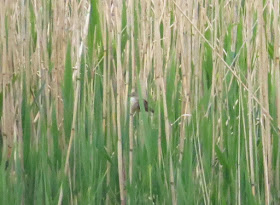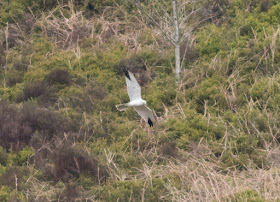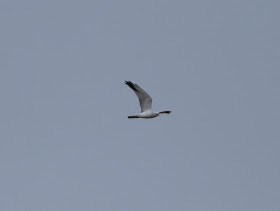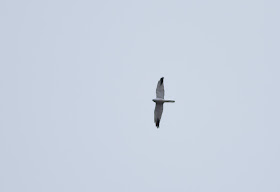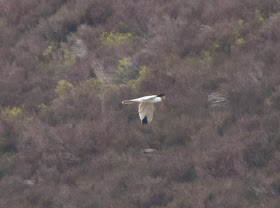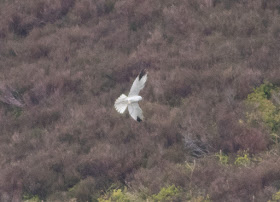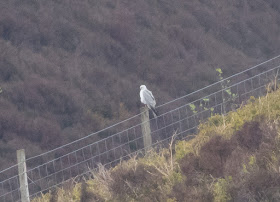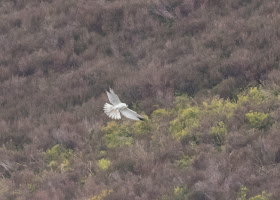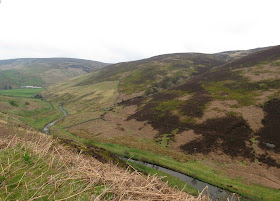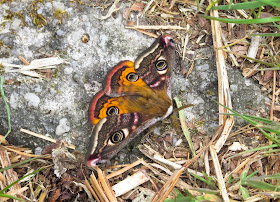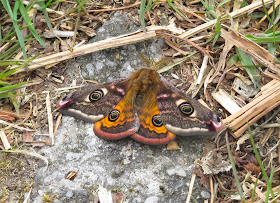Albatrosses are truly a thing of awe – masters of the open oceans and enough to make any land based birder go weak at the knees at the prospect of seeing one cruise past on a seawatch off a British headland. Having never seen an albatross of any kind in either British waters or elsewhere, the thought of a Black-browed Albatross frequenting the seabird cliffs of Bempton RSPB was more than enough to tempt us up to Yorkshire for an all-weekend albatross stake-out.
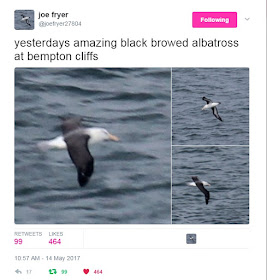 |
| 12 year old Joe Fryer's amazing Black-browed Albatross photos from Bempton! |
First seen and photographed last Saturday by an eagle-eyed 12 year old boy and his Grandad, there had since been a subsequent two more reported sightings during the week from Bartlett Nab viewpoint at Bempton, when the bird was apparently seen flying close in to the cliffs. With no photographs to accompany these two reports however, there has been doubt cast by some amidst possible confusion for the unwary with immature Gannets, but without photographic evidence, who can honestly say they would have instantly believed a 12 year old excitedly running into the RSPB Visitor Centre claiming an albatross!
As to be expected, despite a Saturday and Sunday vigil through rain and shine watching from the cliffs, we didn’t even catch a sniff of the albatross, the bird being reported still from Sylt in Germany on the Saturday evening (having been roosting for 4 hours with swans on the lake at Rantumbrecken while we were battling torrential rain on the cliffs hoping it would pitch up there!) putting paid to any realistic hopes it might materialise off Bempton. Indeed, further reports surfaced later on the Sunday that the bird was still present at Sylt that morning (though we didn’t see this until after we were back!).
Nevertheless, the spectacle of the seabird city that is Bempton was enough to keep us occupied during the weekend, with Kittiwakes, Razorbills and Guillemots galore, along with firm seabird favourite the Puffin putting in several appearances. It was also great to be able to watch the Gannets up close, a small group perched on the cliffs in front of the viewpoint offering a fantastic insight in to their secret oceanic world and providing front row seats to their mesmerising courtship displays and neck dancing.
 |
| Not albatrosses... |
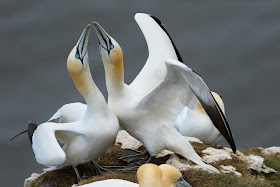 |
| ...but still every bit as beautiful |
With the albatross now seemingly back frequenting the German island of Sylt, having been reported there from Thursday onwards after its sojourn across the North Sea, now that it is aware that Bempton and its thousands of breeding Gannets exists, there is every chance that it could return in the future and settle down for a spell in Yorkshire - in which case we most certainly will be back for another albatross stake out! Indeed it seems to be becoming increasingly disenchanted from its previous favoured spot of Heligoland in Germany, and after realising that no breeding success is to be had there, could well venture further afield in the North Sea in search of a mate.
Having first rocked up at Heligoland back in 2014 this is not the first time the albatross has ventured across the North Sea either - underwing patterns revealed that the Fair Isle bird back on the 28th May last year was one and the same, having made a day trip over to Shetland from Germany, while the presumed same individual was remarkably photographed resting on a pool at Minsmere in Suffolk back on the 12th July 2015. With huge potential to turn up on the east coast, particularly when there have been no recent sightings over in Germany, it could certainly pay off by keeping a watchful eye from Bempton or any other prominent east coast headlands.
For up to date albatross sightings in Germany, it is best to check the ornitho.de website here, where all the recent sightings are displayed in the right hand column, or through the search function.
With perhaps the most famous Northern Hemisphere albatross “Albert” taking up residence for almost 30 years in various Gannet colonies off Scotland (Bass Rock from 1967-1969 and Hermaness in Shetland from 1972-1995) as well as an albatross frequenting the Gannetry at Sula Sgeir during the spring and summers of 2005-2007 for several days each year, hopefully another ‘breeding’ bird will take up residence in a British Gannet colony once more during our lifetime!


